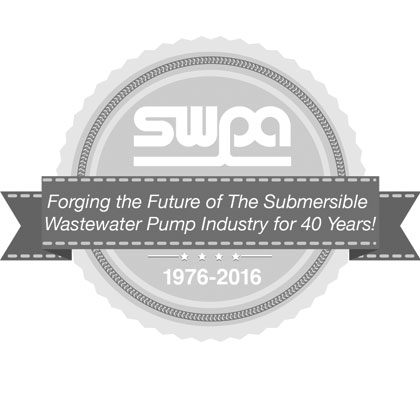Sizing a submersible wastewater system can present complex challenges, but it need not prove difficult if one keeps key concerns in mind. From the selection of pumps and their placement to the sizing of station and discharge piping, the SWPA Handbook provides guideposts for the entire process. In this month’s SWPA Insight, past SWPA president Walt Erndt of Crane Pumps and current SWPA Vice President Lisa Riles of Xylem–Flygt offer their perspectives on sizing a system and share the benefit of their experience.
One of the core components of sizing a wastewater system is pump selection. What are some keys SWPA recommends for choosing the right pump? What are the different concerns for new installations versus retrofits?
Basic system conditions are required including flow and head, NPSH, etc., but there are other conditions that should be considered such as what media is being pumped. Determine if the pump will have to handle challenging conditions. For example, if the lift station pumps have to handle discharge from a restaurant, be aware of potential problems with grease. If discharging from a hospital, there can potentially be issues with ragging from flushable wipes, diapers, and so forth.
When installing a retrofit, it is important that you are aware of the current system requirements. Using the engineer’s original system criteria or just replacing the existing pump in kind may not meet the current system requirements. Changes in the system or system buildout may have created addition pressure requirements that will require a larger pump.
Beyond the pump itself, what considerations are most important for choosing other components—such as station piping, valves, and discharge piping?
Station design to ensure that the complete station is operating properly is critical. The sump design itself is important to make sure the sump is kept clean to prevent odor and pump clogging. Proper check valve selection allows the pumps to operate properly, preventing back up. When choosing a complete pump station from a single supplier, customers can be assured that the pump, piping, valves are designed and constructed to work together. This refers back to last month’s column on “The System Approach.”
What considerations are most important when evaluating a system’s flow requirements, both in its current set-up and for the future?
In general, capacities should be designed for the estimated ultimate population, except for parts of the system that can be readily increased in capacity. Systems should be designed and constructed to give mean velocities of not less than 2.0 feet per second to control sewer gases and to maintain self-cleansing velocities at all rates of flow within the design limits. Consider the pump operating curve and the system curve, locating the BEP, understand if operation is within the Allowable Operating Range or Preferred Operating Range. Consider the use of a VFD in the system to allow for flexibility, future changes in the system conditions and to minimize energy costs.
How should users approach the relationship between sizing a system and peak flow—in addition to intermediate and low flow?
Generally, in sizing a system, engineers study the average daily flow, maximum and minimum daily flows, and peak hourly flow. Peak hourly flows and minimum daily are used to evaluate the sewer system. The maximum daily flow dictates the size of flow equalization facilities, and the sizing of wet wells and pumping equipment. The average daily flow helps to analyze the performance of a plant’s treatment units. It is necessary to use existing conditions to estimate future water flows. If the system has no flow records, the flow may be calculated as a percentage of the total available water supply. Careful study is needed to project wastewater flow. Average flows may vary from 50 to 200 gallons per capita per day.
In stations with multiple pumps, what advice can you offer for placement of pumps?
A typical submersible lift station includes a wet well, a rail system, submersible pumps, valves and a pump control system. In smaller stations, the valves will often be installed in the wet well to save infrastructure costs. On larger systems, it is recommended that a separate valve vault be specified to provide easy access in the event maintenance is necessary. The minimum volume of the wet well needs to handle all inflow rates and as a general rule, it is better to error with a larger wet well. One reason is the discharge piping. Many times the hatch is sized within the manhole correctly, but the discharge piping is forgotten.
Duplex submersible pump stations should be sized so that one pump will be able to handle peak flow events. During events where the inflow exceeds the predicted max flow, the second pump can be used to handle the additional flows. Ample room should be given for the pumps and discharge piping in the wet well with consideration to the station inlet. The inlet placement should not permit the incoming water to fall directly on the pump. ◆
For More Information:
SWPA will be hosting a two-day Pumping Systems and Controls Training Seminar on April 20-21, 2015, in Chicago. For more information, contact SWPA headquarters at 847.681.1868 or visit www.swpa.org.
____________________________________________
MODERN PUMPING TODAY, March 2016
Did you enjoy this article?
Subscribe to the FREE Digital Edition of Modern Pumping Today Magazine!
![]()


